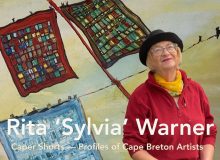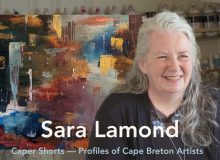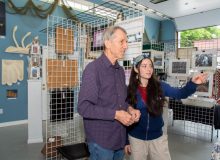
We’re launching Caper Shorts, a fast-paced video profile series featuring the artists and artisans of Cape Breton—starting right here in Richmond County.
We’re Archie Nadon and Elaine Mandrona, a husband and wife team. You can read more about us here.
And to know more about our work, read some of the posts in The Scrape Magazine.
The video format
It will be a sit-down interview with B-roll over top. Our interview with you acts as the voiceover; the B-roll is the footage that gives context or shows your process. Think of it as a relaxed conversation, with cutaways showing you at work. A lot of profiles of artists are done this way because it’s simple and the subject can get comfortable and give thoughtful answers.
What to expect as a participant
Your end of it will be fairly simple. After a little preliminary back and forth by email and maybe a Zoom meeting—especially if we haven’t met you before—we’ll set up a time to visit you in your place of creativity.
We will set up a camera or two, maybe a light if it’s necessary, hook you up to a lapel mic and talk. We’ll ask you about your background and how you got into the work you’re doing.
We’ll then record you in your studio or workspace doing what you do—whether that’s sketching, carving, assembling, or anything else. We’ll also get a few relaxed, candid shots and have you walk us through some of your finished work on camera.
A lot of this will be discussed in advance so we can get right into it. However, we won’t ask all the questions ahead of time. Often it’s the first time a subject answers that is the freshest. But remember, it’s not live and it’s not a final exam. If you don’t like the answer you gave, you can do another take. Or two. Maybe even three.
Model Release
For this sort of media work it is common to have the subject sign a model release and sometimes a property release. It’s not a scary document. We have an app and you fill out the forms, we take a mug shot of you and you get a copy via email. This just ensures we have your permission to use the footage and images as part of the project. Here is what you’ll be signing. (This opens in a new tab.)
Title Card Photo
We’ll need a photo for the video’s title card. Usually, we can pull a still from the footage, but if needed, we’ll take a few extra photos to match the series’ look.
Tips for Subjects
In this video format, it will be just you speaking, so you’ll need to answer slightly differently than if the audience could hear the questions.
For example:
Q: What inspired the piece you’re working on now?
A: It just sort of came to me.
That response may make sense in conversation, but it doesn’t offer enough context when heard on its own. A clearer version might be:
A: This painting of the beach was inspired by the changing light in late fall—those dim, golden days—and wanted to capture that feeling in this piece.
Also, avoid talking over the interviewer. If you do, we can’t edit it out. Let them finish their sentences before you respond.
Don’t worry. We’ll remind you of these things when we’re recording, so no pressure to memorize this. And we can always do another take.
If you have any questions message The Scrape Magazine on Facebook Messenger or email me at archienadon[at]gmail[dot]com






